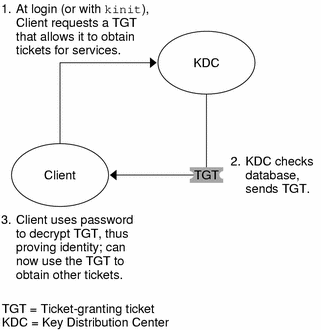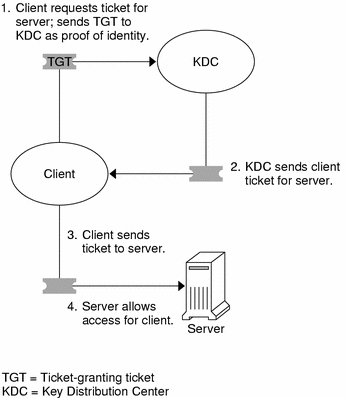Introduction to SEAM
This chapter provides an introduction to Sun Enterprise Authentication Mechanism (SEAM).
What Is SEAM?
SEAM is a client/server architecture that provides secure transactions over networks. SEAM offers strong user authentication, as well as data integrity and data privacy. Authentication guarantees that the identities of both the sender and the recipient of a network transaction are true. SEAM can also verify the validity of data being passed back and forth (integrity) and encrypt the data during transmission (privacy). Using SEAM, you can log on to other machines, execute commands, exchange data, and transfer files securely. Additionally, SEAM provides authorization services, which allows administrators to restrict access to services and machines. Moreover, as a SEAM user, you can regulate other people's access to your account.
SEAM is a single-sign-on system, which means that you only need to authenticate yourself to SEAM once per session, and all subsequent transactions during the session are automatically secured. After SEAM has authenticated you, you do not need to authenticate yourself every time you use a SEAM-based command such as kinit or klist, or access data on an NFS file system. Thus, you do not have to send your password over the network, where it can be intercepted, each time you use these services.
SEAM is based on the Kerberos V5 network authentication protocol that was developed at the Massachusetts Institute of Technology (MIT). People who have used Kerberos V5 should therefore find SEAM very familiar. Since Kerberos V5 is a de facto industry standard for network security, SEAM promotes interoperability with other systems. In other words, because SEAM works with systems that use Kerberos V5, it allows for secure transactions even over heterogeneous networks. Moreover, SEAM provides authentication and security both between domains and within a single domain.
Because SEAM is based on, and designed to interoperate with, Kerberos V5, this manual often uses the terms "Kerberos" and "SEAM" more or less interchangeably, for example, "Kerberos realm" or "SEAM-based utility." Moreover, "Kerberos" and "Kerberos V5" are used interchangeably. The manual draws distinctions when necessary.
SEAM allows for flexibility in running Solaris applications. You can configure SEAM to allow both SEAM-based and non-SEAM-based requests for network services such as the NFS service. As a result, current Solaris applications still work even if they are running on systems on which SEAM is not installed. Of course, you can also configure SEAM to allow only SEAM-based network requests.
Additionally, applications do not have to remain committed to SEAM if other security mechanisms are developed. Because SEAM is designed to integrate modularly into the Generic Security Service (GSS) API, applications that make use of the GSS-API can utilize whichever security mechanism best suits its needs.
How SEAM Works
The following is an overview of the SEAM authentication system. For a more detailed description, see "How the Authentication System Works".
From the user's standpoint, SEAM is mostly invisible after the SEAM session has been started. Initializing a SEAM session often involves no more than logging in and providing a Kerberos password.
The SEAM system revolves around the concept of a ticket. A ticket is a set of electronic information that serves as identification for a user or a service such as the NFS service. Just as your driver's license identifies you and indicates what driving permissions you have, so a ticket identifies you and your network access privileges. When you perform a SEAM-based transaction (for example, if you rlogin in to another machine), you transparently send a request for a ticket to a Key Distribution Center, or KDC. The KDC accesses a database to authenticate your identity and returns a ticket that grants you permission to access the other machine. "Transparently" means that you do not need to explicitly request a ticket.
Tickets have certain attributes associated with them. For example, a ticket can be forwardable (which means that it can be used on another machine without a new authentication process), or postdated (not valid until a specified time). How tickets are used (for example, which users are allowed to obtain which types of ticket) is set by policies that are determined when SEAM is installed or administered.
Note - You will frequently see the terms credential and ticket. In the greater Kerberos world, they are often used interchangeably. Technically, however, a credential is a ticket plus the session key for that session. This difference is explained in more detail in "Gaining Access to a Service Using SEAM".
The following sections further explain the SEAM authentication process.
Initial Authentication: the Ticket-Granting Ticket
Kerberos authentication has two phases: an initial authentication that allows for all subsequent authentications, and the subsequent authentications themselves.
The following figure shows how the initial authentication takes place.
Figure 6-1 Initial Authentication for SEAM Session

A client (a user, or a service such as NFS) begins a SEAM session by requesting a ticket-granting ticket (TGT) from the Key Distribution Center (KDC). This request is often done automatically at login.
A ticket-granting ticket is needed to obtain other tickets for specific services. Think of the ticket-granting ticket as similar to a passport. Like a passport, the ticket-granting ticket identifies you and allows you to obtain numerous "visas," where the "visas" (tickets) are not for foreign countries but for remote machines or network services. Like passports and visas, the ticket-granting ticket and the other various tickets have limited lifetimes. The difference is that "Kerberized" commands notice that you have a passport and obtain the visas for you. You don't have to perform the transactions yourself.
The KDC creates a ticket-granting ticket and sends it back, in encrypted form, to the client. The client decrypts the ticket-granting ticket by using the client's password.
Now in possession of a valid ticket-granting ticket, the client can request tickets for all sorts of network operations for as long as the ticket-granting ticket lasts. This ticket usually lasts for a few hours. Each time the client performs a unique network operation, it requests a ticket for that operation from the KDC.
Subsequent Authentications
After the client has received the initial authentication, each individual authentication follows the pattern that is shown in the following figure.
Figure 6-2 Obtaining Access to a Service

The client requests a ticket for a particular service from the KDC by sending the KDC its ticket-granting ticket as proof of identity.
The KDC sends the ticket for the specific service to the client.
For example, suppose user joe wants to access an NFS file system that has been shared with krb5 authentication required. Since he is already authenticated (that is, he already has a ticket-granting ticket), as he attempts to access the files, the NFS client system automatically and transparently obtains a ticket from the KDC for the NFS service.
The client sends the ticket to the server.
When using the NFS service, the NFS client automatically and transparently sends the ticket for the NFS service to the NFS server.
The server allows the client access.
These steps make it appear that the server doesn't ever communicate with the KDC. The server does, though; it registers itself with the KDC, just as the first client does. For simplicity's sake, we have left that part out.
Principals
A client in SEAM is identified by its principal. A principal is a unique identity to which the KDC can assign tickets. A principal can be a user, such as joe, or a service, such as nfs.
By convention, a principal name is divided into three parts: the primary, the instance, and the realm. A typical SEAM principal would be, for example, joe/admin@ENG.EXAMPLE.COM, where:
joe is the primary. The primary can be a user name, as shown here, or a service, such as nfs. The primary can also be the word host, which signifies that this principal is a service principal that is set up to provide various network services.
admin is the instance. An instance is optional in the case of user principals, but it is required for service principals. For example: if the user joe sometimes acts as a system administrator, he can use joe/admin to distinguish himself from his usual user identity. Likewise, if joe has accounts on two different hosts, he can use two principal names with different instances (for example, joe/denver.example.com and joe/boston.example.com). Notice that SEAM treats joe and joe/admin as two completely different principals.
In the case of a service principal, the instance is the fully qualified host name. bigmachine.eng.example.com is an example of such an instance so that the primary/instance might be, for example, host/bigmachine.eng.example.com.
ENG.EXAMPLE.COM is the SEAM realm. Realms are discussed in "Realms".
The following are all valid principal names:
joe
joe/admin
joe/admin@ENG.EXAMPLE.COM
nfs/host.eng.example.com@ENG.EXAMPLE.COM
host/eng.example.com@ENG.EXAMPLE.COM



